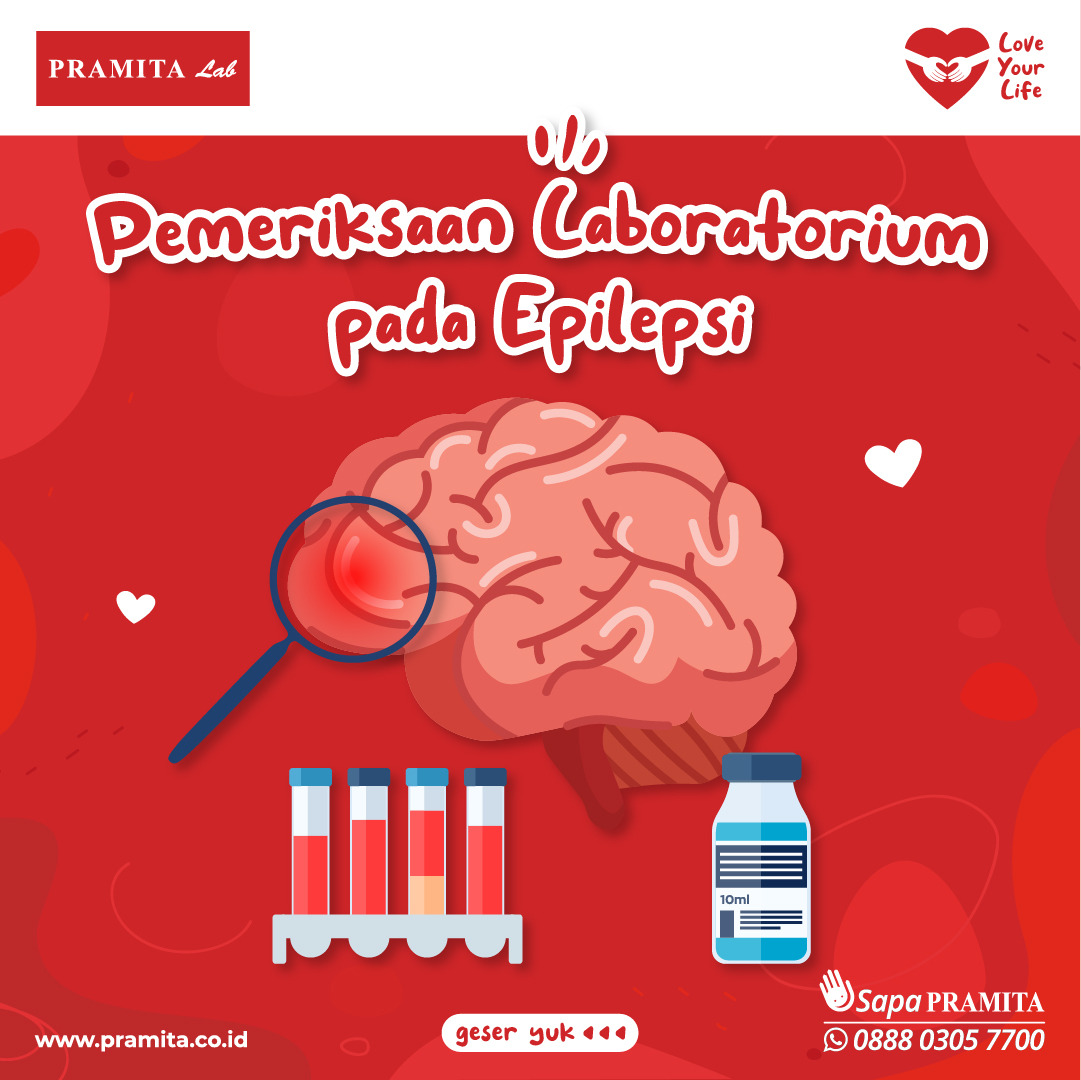Healthy Inspirations
Semua
Work Life
INFO PEMERIKSAAN
Parenting/Kesehatan Anak
LabPedia
Life Style
Kesehatan Wanita
Health Info
Millenial
Info Kesehatan
Mitos/Fakta

LABORATORY EXAMINATIONS IN EPILEPSY
Thu, 22 Dec 2022
The nervous system is a complex system whose job is to regulate every activity in our body, consciously or unconsciously, such as heart rate, respiratory rate, stimulation, and others.
Disorders of the nervous system can cause various symptoms. One of them is seizures and loss of consciousness. Seizures to loss of consciousness can occur in diseases namely Epilepsy.
However, not all seizure complaints are epilepsy.
An in-depth examination based on interviews, examination by a doctor and supporting examinations needs to be carried out to establish a diagnosis of epilepsy, including:
1. Laboratory examination
Risk factors for epilepsy can be caused by electrolyte disturbances (such as low blood sugar levels/hypoglycemia, low sodium levels/hyponatremia and low blood calcium levels or hypocalcemia).
Several tests are related to the above risk factors, such as:
• General check up
• Electrolyte levels (potassium, sodium, calcium and magnesium)
• Blood sugar levels fasting and 2 hours after eating
• Fat Content (Lipids)
• Organ function, such as Liver function (SGOT and SGPT), kidney function (urea and creatinine)
• Hemostatic physiology
• Albumins
• Lumbar puncture, if associated with central nervous system infection
• Prolactin
2. Radiological examination
Radiological examinations are carried out to look for signs of infection or blockages in the nerves, especially in the brain. Checks that can be done are:
• Thorax X-ray
• MRI/CT Scan of the Head, useful for detecting lesions/abnormal tissue foci in the brain that trigger epilepsy such as brain tumors.
3. Electrodiagnosis Examination
Examination which is the gold standard in diagnosing epilepsy is an EEG / Electroencephalography examination. EEG is a test used to detect electrical activity in the brain using electrodes (small metals) placed on the scalp. The cells in our brain work by sending electrical signals that will always be active even when we are asleep, where this activity will be recorded and displayed as a wave line by the EEG device.
》 Inspection indications are as follows:
1. Differentiate seizures caused by epilepsy or other causes
2. Consider temporarily stopping the provision of antiepileptic drugs
3. Monitor brain function in patients treated in intensive care / ICU
4. Determine the prediction of the course of the disease in a coma.
》Preparation for EEG Examination*
Before an EEG examination, it is advisable to consult with a doctor first about any drugs that may be consumed. In addition, make sure that you have washed your hair and have not used conditioner/styling products after washing your hair or spray or gel products on your hair during the examination. Before the examination it is also not recommended to consume caffeine in the 24 hours before the examination.
》Examination Procedure
1. The patient will be asked to lie down/sit consciously relaxed and comfortable on the table/bed provided
2. The patient's head will be measured and marked for the location of the electrodes
3. Electrodes will be installed and will be wired to the instrument so that it amplifies the waves and can record electrical activity
4. This examination takes 60 minutes. The patient will also be recorded electrical activity while sleeping, opening and closing the eyes, simple calculations, reading, looking at pictures, breathing quickly and shallowly, and seeing lights and flashing lights/ photic stimulation.
Note: this EEG examination is reported to be almost non-existent, so it is a relatively safe examination for patients. However, this examination also has the potential to cause damage to the skin.
Author: dr. Ni Made Ayu Andini Rahmawati (Consultant Medical Doctor for PRAMITA Clinical Laboratory Jl. Diponegoro No. 148, Denpasar Bali)
Disorders of the nervous system can cause various symptoms. One of them is seizures and loss of consciousness. Seizures to loss of consciousness can occur in diseases namely Epilepsy.
However, not all seizure complaints are epilepsy.
An in-depth examination based on interviews, examination by a doctor and supporting examinations needs to be carried out to establish a diagnosis of epilepsy, including:
1. Laboratory examination
Risk factors for epilepsy can be caused by electrolyte disturbances (such as low blood sugar levels/hypoglycemia, low sodium levels/hyponatremia and low blood calcium levels or hypocalcemia).
Several tests are related to the above risk factors, such as:
• General check up
• Electrolyte levels (potassium, sodium, calcium and magnesium)
• Blood sugar levels fasting and 2 hours after eating
• Fat Content (Lipids)
• Organ function, such as Liver function (SGOT and SGPT), kidney function (urea and creatinine)
• Hemostatic physiology
• Albumins
• Lumbar puncture, if associated with central nervous system infection
• Prolactin
2. Radiological examination
Radiological examinations are carried out to look for signs of infection or blockages in the nerves, especially in the brain. Checks that can be done are:
• Thorax X-ray
• MRI/CT Scan of the Head, useful for detecting lesions/abnormal tissue foci in the brain that trigger epilepsy such as brain tumors.
3. Electrodiagnosis Examination
Examination which is the gold standard in diagnosing epilepsy is an EEG / Electroencephalography examination. EEG is a test used to detect electrical activity in the brain using electrodes (small metals) placed on the scalp. The cells in our brain work by sending electrical signals that will always be active even when we are asleep, where this activity will be recorded and displayed as a wave line by the EEG device.
》 Inspection indications are as follows:
1. Differentiate seizures caused by epilepsy or other causes
2. Consider temporarily stopping the provision of antiepileptic drugs
3. Monitor brain function in patients treated in intensive care / ICU
4. Determine the prediction of the course of the disease in a coma.
》Preparation for EEG Examination*
Before an EEG examination, it is advisable to consult with a doctor first about any drugs that may be consumed. In addition, make sure that you have washed your hair and have not used conditioner/styling products after washing your hair or spray or gel products on your hair during the examination. Before the examination it is also not recommended to consume caffeine in the 24 hours before the examination.
》Examination Procedure
1. The patient will be asked to lie down/sit consciously relaxed and comfortable on the table/bed provided
2. The patient's head will be measured and marked for the location of the electrodes
3. Electrodes will be installed and will be wired to the instrument so that it amplifies the waves and can record electrical activity
4. This examination takes 60 minutes. The patient will also be recorded electrical activity while sleeping, opening and closing the eyes, simple calculations, reading, looking at pictures, breathing quickly and shallowly, and seeing lights and flashing lights/ photic stimulation.
Note: this EEG examination is reported to be almost non-existent, so it is a relatively safe examination for patients. However, this examination also has the potential to cause damage to the skin.
Author: dr. Ni Made Ayu Andini Rahmawati (Consultant Medical Doctor for PRAMITA Clinical Laboratory Jl. Diponegoro No. 148, Denpasar Bali)

